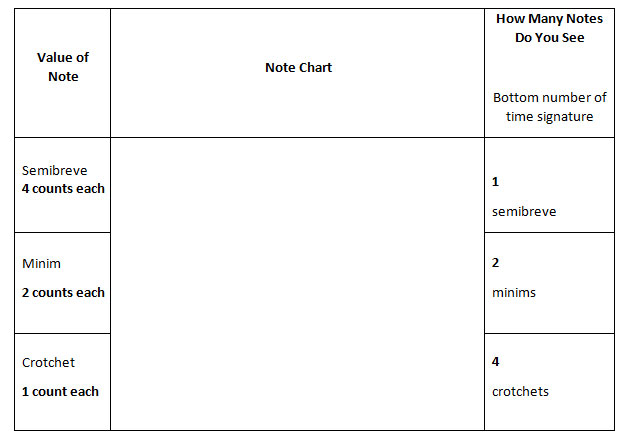Timing & Tempo Improvement
Lesson One – Understanding Time Signatures
- Time Signatures are two numbers stacked on top of each other that appear once at the beginning of a piece of music. Any changes in the time signature will be indicated on the score.
- The time signature tells us two essential details about the music:
- How many beats there are in each bar and
- What kind of beats we are using.For example:

Using the chart below, you can break down the information inside a time signature:

To understand the time signature of

This will mean that there are two crotchet beats per bar
Another way of explaining the concept of time signatures is:
- The top number is the most important. It tells us how many counts are in each bar
- The bottom number is a riddle.
If the number says 4, then we have to think backward
There are 4 “x” notes inside the semibreve
We need to find the value of “x.”
Ask yourself how many counts the semibreve is worth – 4 counts.
Ask yourself to hold up four fingers.
Ask yourself the value of each finger – i.e., each finger is worth one count.
The value of “x” is one count.
Ask yourself which note value is worth one count. You should arrive at the answer of a crotchet.
The time signature should now read two crotchet beats per bar.

Lesson Two – Understanding Time in Music
Time and rhythm are often confused as being the same thing. They are not.
- Time refers to the beat or pulse of the music.
- Rhythm refers to the short and long sounds that may be pitched or unpitched.
- Pitch refers to how high or low a sound is
Time can be divided into simple or compound time.
Simple time signatures (2/4, 3/4, 4/4, 3/2, 4/2, 3/8) are plain, undotted, and divisible by two.
That means the base beat comprises crotchets (4) or quavers (8).
These notes can be divided evenly.
For example, crotchets can be divided evenly into quavers, and quavers can be evenly divided into semiquavers.
The example below demonstrates how Simple Triple Time (3/4) works.
The time signature tells us there are three beats in each bar, and the value of each moment is a crotchet.
For each crotchet value, we can subdivide that into two quavers.

Compound time signatures are different. They are dotted and divisible by three.
These include 6/8, 9/8, 12/8, and 6/4.
An example is given below for 6/8 time.
Also known as Compound Duple time because the beats are dotted (compound), and there are two beats (duple). Each dotted crotchet beat can be subdivided into three quavers.

You will notice that both examples (simple triple and compound duple) have a total of six quavers. However, they are grouped differently and, as a result, will be played differently.
Lesson Three – Understanding Accenting
Once you have established the time signature and a steady beat, you can move on to accenting.
- Accepting help us shape musical phrases
- The first beat is always the strongest and is shown with the accent sign >
- The medium accent is the next strongest beat and is demonstrated with this sign–
- Most pieces of music will follow one of the patterns described below. If you have a metronome, you may also notice that you can set a different tone for the accents. This is crucial for improving your timing when you play.



Lesson Four – Practical Ways to Improve Time
The following tips may help you to improve your timing at the piano:
- Practice finding the beat and clapping it to as many different songs as possible. Try to use a wide variety of genres, instruments, and styles.
- Once you are comfortable finding the beat, see if you can identify the kind of time signature – is the work in simple or compound time.
- See if you can then identify the precise time signature – simple duple, triple, quadruple.
- Before playing the piece at the piano, write out the rhythm and clap it out against a metronome at half speed.
- Keep the metronome going slowly and work for hands separately before attempting to work or increase the speed.
- Listen to simple melodies and notate the rhythm while tapping out the beat with your other hand.
- Consider practicing three against two rhythms (also known as polyrhythms) as tapping patterns or scales.
- Consider downloading rhythm training apps on your phone so you can practice away from the piano. Some interesting ones include Rhythm Trainer and Perfect Ear.
- Record yourself with a metronome, and you will see a difference in your performance without one.
- Challenge yourself constantly with sight reading (usually a grade or two below what you are comfortable playing) to practice consistent timing
Lesson Five – Answers to the Aural Tests
Tchaikovsky Nutcracker Overture
Bach –BWV 989
Rachmaninoff – Three Russian Songs op.41
Tchaikovsky –Dance of the Sugar Plum Fairy
Grieg – Morning
Debussy – Clair de Lune
Saint-Saens – The Swan
Tchaikovsky – Barcarolle
Chopin – Nocturne in F Major
Bach – Jesu Joy of Man’s Desiring

Lesson Six – Answers to the Aural Tests
Mozart – Don Giovanni Overture
JuliusH – Tango de Salon
Piaf – Hymne A L’Amour
Trad. Amazing Grace
Elvis Presley – Can’t Help Falling in Love
Bach – Toccata and Fugue in D Minor
Beethoven – Sonata Pathetique (Adagio)
Schubert – Ave Maria
Julius H – Flamenco Guitar Duo
Mozart – Voi Che Sapete
(Le Nozze Di Figaro)

 If you wish to download the files to your desktop, simply right click the link below and select ‘save as’
If you wish to download the files to your desktop, simply right click the link below and select ‘save as’
Then select the location you wish to save the files to (either your DESKTOP or MY DOCUMENTS e.t.c.)
Once finished, simply unzip the files (PC use Winzip, MAC use Stuffit) and your files will be there.
All written material can be opened as a PDF.
All video files can be opened with VLC Media Player.
Select your download option below …
